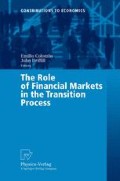Abstract
The design of an appropriate regulatory framework for banks is one of the crucial aspects for the development of financial markets in transitional economies. Banking policies are usually invoked to deal with moral-hazard problems. We believe that banking policies (and the exchange rate regime) should also be designed with the aim of ensuring an adequate provision of liquidity in the event of self-fulfilling bank runs. We reconsider some of the issues discussed in Chang and Velasco (1998a; 1998b) within a different version of the Diamond and Dybvig model (1983). We argue that the stability of the domestic banking sector should be treated as an issue distinct from that of capital account liberalisation. Fixed exchange rates are vulnerable to sudden capital reversals but benefit from long-term inflows. By contrast a deregulated domestic bank sector remains illiquid even when foreign debt is entirely long-term. We also discuss the impact of an external (interest rate) shock on the fragility of the domestic banking system. Our basic point is that the choice of the exchange rate regime and of the policy mix cannot neglect the need to ensure the financial stability issue. More precisely an external shock requires a redistributive policy that subsidises banks Under a fixed exchange rate system an appropriate fiscal intervention must be designed. The same result can be obtained by means of a monetary surprise if the exchange rate is flexible and the deposit contract is not indexed.
Access this chapter
Tax calculation will be finalised at checkout
Purchases are for personal use only
Preview
Unable to display preview. Download preview PDF.
References
Blanchard O., Missale A. (1994) The Debt Burden and Debt Maturity. American Economic Review 84:309–319
Chang R., Velasco A. (1998a) Financial Crises in Emerging Markets: A Canonical Model. Working Paper 6606
Chang R., Velasco A. (1998b) The Asian Liquidity Crisis. New York University, C.V. Starr Center for Applied Economics, RR. 98–27
Corsetti G., Pesenti P., Roubini N. (1998) What Caused the Asian Currency and Financial Crisis?. Japan and the World Economy 11:305–373
Diamond P., Dybvig P. (1983) Bank Runs, Deposit Insurance and Liquidity. Journal of Political Economy 85:191–206
European Bank for Reconstruction and Development (1998) Transition Report, Financial Sector in Transition. London, EBRD
Goodahrt C., Huang H. (1999) A Model of the Lender of Last Resort. IMF Working Paper 99/39
Grilli V., Garber P. (1989) Bank Runs in Open Economies and the International Transmission of Panics. Journal of International Economics 27:165–75
Krugman P. (1999) Balance Sheets, the Transfer Problem and Financial Crises. Mimeo MIT
Masson P. (1998) Contagion-Monsoonal Effects, Spillovers and Jumps between Multiple Equilibria. IMF Working Paper 98/142
Miller V. (1998) Domestic Bank Runs and Speculative Attacks on Foreign Currencies. Journal of International Money and Finance 17:331–38
Radelet S., Sachs J (1998) The Onset of the East Asian Financial Crisis. NBER Working Paper N. 6680
Rother P. (1999) Explaining the Behavior of Financial Intermediation: Evidence from Transition Economies. WP/99/36, IMF
Talley S., Giugale M., Polastri R. (1998) Capital Inflow Reversals, Banking Stability and Prudential Regulation in Central and eastern Europe. Mimeo, World Bank
Wallace N. (1996) Narrow Banking Meets the Diamond-Dybvig Model. Federal Reserve Bank of Minneapolis Quarterly Review 20:3–13
Author information
Authors and Affiliations
Editor information
Editors and Affiliations
Rights and permissions
Copyright information
© 2003 Springer-Verlag Berlin Heidelberg
About this chapter
Cite this chapter
Lossani, M., Tirelli, P. (2003). Financial Instability in the Transition Economies: Lessons from East (Asia) for (East) Europe. In: Colombo, E., Driffill, J. (eds) The Role of Financial Markets in the Transition Process. Contributions to Economics. Physica, Heidelberg. https://doi.org/10.1007/978-3-642-57372-9_6
Download citation
DOI: https://doi.org/10.1007/978-3-642-57372-9_6
Publisher Name: Physica, Heidelberg
Print ISBN: 978-3-7908-0004-3
Online ISBN: 978-3-642-57372-9
eBook Packages: Springer Book Archive

